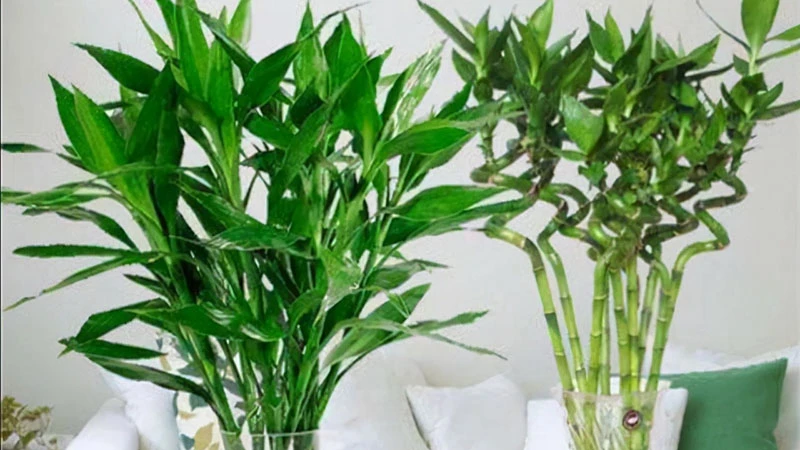Lucky Bamboo (Dracaena sanderiana 富贵竹), also known as “Wealth Bamboo” or “Fortune Bamboo,” is a common indoor plant cherished for its symbolic meanings of prosperity, longevity, and good fortune. Whether in homes or offices, its ability to thrive with minimal care makes it a popular choice for décor. However, keeping it healthy and flourishing requires an understanding of its needs. This guide will explore essential care tips for Lucky Bamboo, ensuring that it remains vibrant and a source of positive energy.
The Biology and Growth Needs of Lucky Bamboo
Originating from Central and Western Africa, Lucky Bamboo is a member of the Asparagaceae family, known for its long, green, and glossy leaves. It is highly adaptable, capable of growing in both soil and water, although the latter is more commonly preferred for indoor settings. With its impressive resilience, Lucky Bamboo tolerates low light conditions and is ideal for interior spaces with limited natural light. Its upright, sturdy stems and elegant appearance make it a staple in modern homes and offices.
Despite its low-maintenance reputation, there are specific environmental conditions that contribute to its optimal growth.

Light, Water, and Temperature Management
One of the most vital elements in maintaining a thriving Lucky Bamboo is providing appropriate light. Although it prefers indirect light, exposure to harsh, direct sunlight can damage its leaves, leading to yellowing or even scorching. For the best results, place Lucky Bamboo in an area where it can receive bright, filtered light, such as near a shaded window. Too much shade, on the other hand, can slow down its growth and dull the sheen of its leaves. Striking a balance between light and shade ensures that the plant remains healthy without compromising its beauty.
Keeping Roots Happy
Water is the lifeline of Lucky Bamboo, particularly when it’s grown hydroponically. It’s crucial to keep the water clean and fresh by replacing it once or twice a week. The water level should cover about one-third of the stem, preventing the plant from submerging completely, which can lead to root rot. Additionally, using filtered or distilled water is recommended, as tap water containing chlorine or fluoride may damage the plant over time. Regularly monitor the water for any foul odors or discoloration, and clean the container periodically to maintain hygiene.
For soil-grown Lucky Bamboo, the key is to keep the soil moist but not waterlogged. Overwatering can cause the roots to rot, so a well-draining potting mix is ideal. During warmer months, you may need to water more frequently, but always ensure the soil dries out slightly between watering sessions.
Temperature and Humidity
Lucky Bamboo thrives in a warm and humid environment, mimicking its native tropical climate. Ideally, it should be kept at temperatures between 20°C to 30°C (68°F to 86°F). Cold temperatures below 10°C (50°F) can stunt its growth and even kill the plant. To protect it from the cold, especially in winter, keep it away from drafty windows or air conditioning vents.
Humidity is another important factor, as Lucky Bamboo prefers environments with 60-80% humidity. If the air is too dry, consider misting the leaves occasionally or placing the plant near a humidifier. For indoor settings, these small adjustments help create a more favorable atmosphere for the plant.
Fertilization and Pruning
While Lucky Bamboo does not have high nutrient demands, occasional feeding can help it flourish. A diluted liquid fertilizer, applied once a month during the growing season, provides the necessary nutrients for vibrant leaf color and strong stem growth. However, it’s crucial not to over-fertilize, as too many nutrients can cause the leaves to turn yellow or brown. In winter, when the plant’s growth naturally slows down, there is no need for fertilization.
For water-grown plants, using a specialized hydroponic fertilizer can be beneficial. Always ensure that the fertilizer is well-diluted to prevent burning the roots.
Regular pruning is important to maintain Lucky Bamboo’s shape and prevent it from becoming too leggy. Over time, the plant can grow quite tall, which may detract from its overall aesthetic. Use clean, sharp scissors to trim any excess growth, focusing on cutting just above a node (the point where leaves or branches emerge). You can also remove any yellow or unhealthy leaves to keep the plant looking its best.
Moreover, the trimmings can be repurposed for propagation. Simply place the cuttings in water, and they will begin to grow roots, giving you new Lucky Bamboo plants to share or expand your collection.
A Symbol of Luck and Prosperity
Beyond its decorative appeal, Lucky Bamboo holds deep cultural significance, particularly in Chinese traditions. It is often gifted during important life events, such as weddings, housewarmings, or the Lunar New Year, as a symbol of prosperity, health, and longevity.
In Feng Shui (风水), Lucky Bamboo is often placed in specific areas of a home or office to attract positive energy (Qi). It is commonly located in the “wealth” or “health” corners of a room, based on the principles of Feng Shui. The plant’s association with strength and resilience, combined with its air-purifying properties, makes it a perfect addition to both living spaces and work environments.


